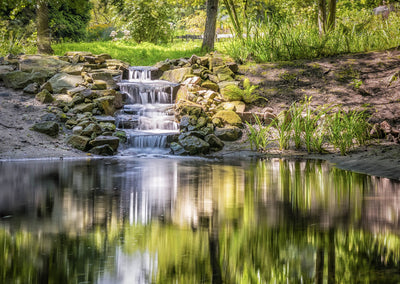Landscaping with Light
Landscaping with light is a popular way of enhancing landscape plantings, turf, and gardens. This is done through the use of low voltage lighting systems. Besides the added dimension night lighting provides in the landscape, landscaping with light gives additional safety and security around the home.
Designing with light requires the same sort of planning that the landscape does. Identify the area or areas to be lit and select their most striking features. One or 2 focal points in each area is adequate. These focal points can be trees, pathways, flower beds, or fences. Additional lighting effects should be placed to support the focal points. Every landscape also has areas that should remain unlit. Installation of the lighting units is easier if there is some kind of plan to follow. Having the elements of the landscape on paper can allow for light manipulation well before any actual hand labor is involved.
Listed below are some guidelines to help create an attractive landscaping with light plan.
- Use various lighting techniques such as cross lighting or spotlighting to add visual interest.
- Conceal the light source behind bushes, shrubs, trees, or flowers.
- Don't over light an object. A subtle lighting effect is usually more desirable.
- Strive for a natural look. Night lighting should imitate moonlight without glare.
- Illuminate any potential obstacles such as steps, paths, or changes in sidewalk level.
- Keep in mind the servicing of the lights. Will they be easy to reach when bulbs need replacing or cleaning.
- The most important element of landscape lighting is the lighting effect, not the light fixtures. During the day the fixtures should blend naturally into the landscape.
- Keep light color in mind. Different light sources produce different light colors. Select one lamp as the primary light source and use the others for special effects.
Low voltage lighting systems operate off of a 120-volt electrical outlet and a power pack. The power pack reduces the electrical current to 12 volts. This ensures there will be no electrical shock even if contact is made with bare wires. Power packs are available with wattages ranging from 100-900 watts. They may feature photocells, remote controls, and built in motion/heat sensors. To determine the correct size of power pack to purchase, add up the total wattages of each fixture specified for the installation. This number is known as the total nominal wattage (TNW). Generally the TNW rating should not be more than double the total wattage of the lamps. For example, your job will use 6 fixtures each with a 20 watt bulb. The fixture's TNW is 120 (6 x 20). The power pack selected should not be rated for more than 240 (120 x 2). If the fixtures TNW is too high, divide the electrical load between more than 1 power pack or switch to a higher unit. In large installations, it is not uncommon to use several power packs. Follow the installation instructions provided by the manufacturer of your system for proper installation.
Once properly installed, low-voltage lighting systems require little care. Removal of dirt, leaves, and debris will be needed occasionally. Check fixtures regularly and make the adjustments that are needed. The cable where the lights are attached should be checked at least once a year for damage. Replace burnt out bulbs immediately. The voltage that the burnt out bulb no longer uses flows to the remaining operating bulbs reducing their life.
Gardeners can choose from several different fixtures. Tier or accent lights define paths, walkways, or steps as well as provide warmth and illumination without an upward glare. Light is projected downward around the base of the fixture in a soft ring. Mushroom and walk lights highlight areas of low foliage borders, walkways, paths, and groundcovers. The lights' large shade conceals the light source. Floodlights allow areas to come alive at night. They are aimed up and down fences or walls to highlight texture differences or to shadow the movement of bushes and trees. Step and surface mount lights provide subtle accent lighting for increased safety along sidewalks, buildings, pools, and paths. They direct light in a controlled pattern eliminating glare. Well lights conceal the light source at ground level. They direct the light upward to create special effects.
Landscaping with light is an easy do it yourself project provided some forethought is involved. Several manufacturers supply local garden centers, nurseries, and lumber yards with a variety of lighting systems. Plan your needs on paper first, then select the proper light sources you'll need to light up your landscape.
- Outdoor lighting makes your home safer and more secure by providing necessary illumination for walkways, steps and entrances.
- The use of outdoor lighting, in conjunction with timers and photo cells, can add even more peace-of-mind by providing a lived-in look while you're away from home and insuring the area around the house is well lit when you arrive home after dark.
- The most common type of outdoor fixture is a brass wall lantern, although materials such as cast aluminum have gained popularity because they are rust resistant.
- Generally, a light mounted to one side of every exterior door is the minimum lighting for the exterior of a house. Try including a lantern or other wall fixture on both sides of the door and a pendant or a post light near driveways and walkways.
- The popularity of using outdoor lanterns indoors is growing. You can use small lanterns to accent powder rooms, small foyers, sitting areas or stairways.






